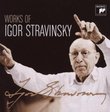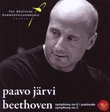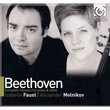| All Artists: Ludwig van Beethoven, Jos van Immerseel, Anima Eterna Orchestra, Klaus Schredl, Bart Meynckens, Anne-Kristiina Kaappola, Annelies Coene, Elisabeth Hermans Title: Beethoven: Symphonies; Ouvertures [Box Set] Members Wishing: 0 Total Copies: 0 Label: Zig Zag Territories Original Release Date: 1/1/2008 Re-Release Date: 4/8/2008 Album Type: Box set, Import Genre: Classical Styles: Ballets & Dances, Ballets, Historical Periods, Classical (c.1770-1830), Symphonies Number of Discs: 6 SwapaCD Credits: 6 |
Search - Ludwig van Beethoven, Jos van Immerseel, Anima Eterna Orchestra :: Beethoven: Symphonies; Ouvertures [Box Set]
![Beethoven: Symphonies; Ouvertures [Box Set]](https://nationalbookswap.com/cd//l/26/6026/6166026.jpg) | Ludwig van Beethoven, Jos van Immerseel, Anima Eterna Orchestra Beethoven: Symphonies; Ouvertures [Box Set] Genre: Classical
|
Larger Image |
CD DetailsSimilar CDs |
CD ReviewsA magnificent achievement Chyron | Antwerp, Flanders, Europe | 07/22/2008 (5 out of 5 stars) "Here is a Beethoven symphony cycle (again) on period instruments (again). So why should it stick out in the midst of dozens of other cycles ? Yet it does stick out. These symphonies by Jos Van Immerseel and his small-scale orchestra Anima Eterna are all fresh, full of tintillating life. In fact, the orchestra is perfectly modelled on the size of the symphony orchestra in Beethoven's time, everything has been done in an effort to recreate the sound that Beethoven sought to create and that he would have heard (or wish to hear)himself. The details about the research and the production are explained in a well-written multilingual booklet included in the box. The sounds. These symphonies are a wealth of sounds, I have never before heard the percussion so clearly and the same goes for practically every individual instrument and yet the music flows and sings with all instruments together, dynamically and harmoniously : this is pure heaven. I'm very fond of Beethoven's symphonies and I have some two dozen complete cycles in my collection but this one goes straight to the top as one of the very, very best." Beethoven, Period J. Genzlinger | 01/14/2009 (5 out of 5 stars) "This latest set of Period Instrument Beethoven symphonies, the first in some time, is terrific. A relatively smallish orchestra by today's standards, the group nevertheless packs real punch, helped by incisive tympani and (natural) brass. Acoustics and engineering are excellent, with a forward and present sound image possessing good depth (listen to the double basses in Sym 7's Allegretto). No need to worry about an over-reverberant hall which spoils some recordings. Rather than point to HIP practice/re-assessment, for which there is an extended essay provided in the notes, this represents simply a first class cycle. Tempos are somewhat close to the norm pacé a refreshingly quick opening to Sym 6. And has the first movement of Sym. 8 ever sounded better, more right? The development section is original head-bagger music, and here I find it impossible not to let loose and jam like a heavy-metal rocker at a rowdy concert (I thought my house walls were going to crumble). Likewise the opening movement of Sym 5 is a whirlwind: what a concise, moody and intense movement this is, superbly realized here! Strings leave nothing to be desired and there are absolutely no intonation issues (listen to their plangent calls in the funeral march of Sym 3 - wow). At all times the players of Anima Eterna are engaged and engaging, their energy jumping out of the speakers. The orchestra is enlarged for Sym 9 but the clarity is still present. Soloists and choir are up to the standard set by the orchestra, and the two forces are nicely balanced. When the soloists sing in ensemble, they are as blended a group as I've heard in this piece, and that's not so easy to bring off. The choir is agile and responsive (what those poor sopranos have to do for Beethoven!). The collection is rounded out with a nice complement of overtures and other small pieces, all played with the same dedication and commitment. For points of reference, my two favorite Beethoven cycles are Harnoncourt (Teldec) and Abbado (Euroarts DVD). I am ashamed to admit that I've never heard Norrington, Gardiner or Hogwood. And I need to explore the new recordings of Vänskä/Minnesota which have gotten such rave reviews, and are recorded in multi-channel. Of course I have other single or multiple discs as well (Wand, MTT, Halász), but this Immerseel set is worthy of your top shelf. While not every performance will likely be your favorite "desert island" version and they probably won't supplant your favorites (they don't mine), Immerseel nevertheless provides a coherent vision of Beethoven's style and unique, revolutionary symphonic language that makes these nine, highly individual works which span about a quarter century, all of a piece. I for one wouldn't want to be without them. Urgently recommended. " A period collection to stand with the best of that ilk Larry VanDeSande | Mason, Michigan United States | 01/31/2009 (4 out of 5 stars) "While nothing in the Jos van Immerseel-Anima Eterna collaboration on Beethoven's symphonies and overtures gave me reason to dump Roger Norrington's first batch, with the London Classical Players, from my personal mountaintop of period couplings, it gave me plenty to chew on and think about and, occasionally, great musicmaking. For the uninitiated, Immerseel is the keyboardist-cum-conductor founder of Anima Eterna, a band of 45 or so players that use period instruments, some originals and others copies, and gut strings. Unlike recent Beethoven recordings by Haitink, Vanska and Norrington that used modern instruments and period-induced style, this set stays true to period mantra by using old instruments.
My experience with Immerseel as chamber musician, soloist and conductor tells me he is a musical moderate, not a dogmatist in the Norrington mold. His interpretations of the symphonies tend to moderate, with only No. 7 being what I would call full blown in your face conducting. The performances are generally satisfying. I would say Symphonies 1,2,4, 5 and 8 are all good or better and 7 is one of the best performances I've ever heard. Commonplace interesting musical details leap out at the listener on every disk, as well. The overtures are lively and the marcia alla turca section from the Ruins of Athens sounds different than any version I've ever heard because of the Turkish band Immerseel put together to play it. But I grade Beethoven sets on how the forces do with the magnanimous triplets -- Symphonies Nos. 3, 6 and 9. Here, I would say Immerseel is not always at his best. The Eroica lacks the gravity most adhere to it while 6 starts a little fast for my taste, even though I was humming along by the end. Symphony No. 9 is something of a watershed for period performance; it is almost a traditional reading in pace, projection, muscial values and singing. While I wasn't always persuaded by the orchestral movemments, the vocal final movement is probably the best reading I've ever heard of that music. It is definitely an ear-opening experience for anyone that's heard the ode to joy once or 1,000 times. The sound on this set -- everything was recorded in the Concertgebouw in Amsterdam -- is exquisite, full of illustrated details, making the most of fruity period winds and horns, and exceptionally natural with marvelous timpani. Even though Anima Eterna is a smallish band, you don't get the impression the scale is small or that this is less than leonine Beethoven. They sound bigger than they are, most of the time, for reasons Immerseel explains in his outstanding notes. And it is this nonmusical element of the production that sets this collection apart from all other period Beethoven collections. Immerseel's outstanding notes address everything -- instruments, performance style, choice of singers and choir, score edition (Del Mar-Bahrenreiter), halls of Beethoven's time, tempi, etc. and completely lack the cult of personality we often find in booklets. Heck, there isn't even a word about any of the vocal soloists (their photos and names appear) or the choir, much less about the conductor or band. These notes are full of interesting stories and judgments. At one point, Immerseel reports that Otto Klemperer once tried to put together a period band and do a cycle of Beethoven symphonies but didn't because there were not enough musicians available that could play it the old way. Equally as enjoyable are Cecile Reynaud's notes on each symphony that include critical reviews of the day by Hector Berlioz, ETA Hoffman and /Robert Schumann. Most enjoyable, for me, was Schumann's comments on the Symphony 9, which he reported listeners variably compared to the creation of the world and the great Pyramids of Egypt. Anyone that loves Beethoven, musical history, or musical information will relish this package. Yet, alas, it's the music you'll play over and over again after reading the notes once. And, in that respect, I don't think thls package sets the same high standard for a number of characteristics irked me. First, even though Immerseel says "selective use of vibrato is part of the aesthetic," the strings often moan in an unattractive way, especially during Eroica. Immerseel takes all the exposition repeats, which turned me off, and he never once interpreted the music differently on repeat. If this was Bach, this would be enough to call the music bland. Finally, Immerseel is the only conductor I know that mercilessly followed the composer's markings that move from true fortissimo (FFF) to pianissimo (PPP) in a single phrase. If there is any sound interference when you hear this, you might think someone turned the volume down on your player. These complaints considered, this set offers good value at less than $40 new for collectors and those wanting to pick up their first, or a new, set of period Beethoven symphonies. I haven't heard all the period sets but I've heard both Norrington sets, Zinman's and Gardiner's and this one can stand up to all but Norrington's first revolutionary offering that started the whole period craze in Beethoven. And, because Immerseel is more moderate in approach than any of the others, his set may appeal to traditional Beethoven listeners that have yet to tip their toes in the pond of period performance." |

 Track Listings (9) - Disc #1
Track Listings (9) - Disc #1



